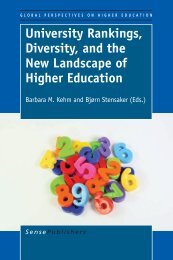Rupturing Concepts of Disability and Inclusion
Rupturing Concepts of Disability and Inclusion
Rupturing Concepts of Disability and Inclusion
Create successful ePaper yourself
Turn your PDF publications into a flip-book with our unique Google optimized e-Paper software.
CHAPTER 2<br />
to deny or inferiorise the experiences <strong>of</strong> different bodies - experiences which may<br />
include pain <strong>and</strong> limitation. Therefore, by exploring the conjunction between differing<br />
<strong>and</strong> excluded bodies such as those represented by women, people <strong>of</strong> colour, <strong>and</strong><br />
people with disability, a space could be opened for the articulation <strong>of</strong> a common<br />
voice to redress structural exclusion.<br />
According to Shulamit Reinharz, feminists choose multiple methods not only for<br />
technical reasons, but to also reflect intellectual, emotional, <strong>and</strong> political commitments<br />
pertaining to feminist concerns. 109 This means, that feminist researchers, combine<br />
many methods so as to “cast their net as widely as possible in the search for<br />
underst<strong>and</strong>ing <strong>of</strong> critical issues.” 110 Therefore, Reinharz states:<br />
26<br />
Feminist descriptions <strong>of</strong> multimethod research express the commitment to<br />
thoroughness, the desire to be open-ended, <strong>and</strong> to take risks. Multiple methods<br />
enable feminist researchers to link past <strong>and</strong> present, “data” gathering <strong>and</strong><br />
action, <strong>and</strong> individual behavior with social frameworks. By combining<br />
methods, feminist researchers are particularly able to illuminate previously<br />
unexamined or misunderstood experiences. 111<br />
Jeanne Braham describes how feminist writer, Jane Flax, also uses multiple<br />
intersecting frames <strong>of</strong> reference to address questions <strong>of</strong> self, gender, knowledge<br />
<strong>and</strong> power, that is to “stitch together fragments” <strong>of</strong> theories in such a way that they<br />
interact <strong>and</strong> “converse” with each other. 112 It is worthy <strong>of</strong> note that fragments are<br />
also most <strong>of</strong>ten the products <strong>of</strong> deconstruction. Colin MacCabe provides an<br />
insightful opinion <strong>of</strong> Gayatri Spivak’s work when he states:<br />
Deconstruction, for Spivak, is neither a conservative aesthetic nor a radical<br />
politics but an intellectual ethic which enjoins a constant attention to the<br />
multiplicity <strong>of</strong> determination. 113<br />
As previously stated, the notion <strong>of</strong> inclusion as a multifaceted concept, is<br />
oppositionally located with multifaceted concepts <strong>of</strong> exclusion. However, these<br />
facets, representing many fragments <strong>of</strong> knowledge <strong>and</strong> many texts <strong>of</strong> underst<strong>and</strong>ing,<br />
are not free-floating. They are embedded in particular spaces.<br />
Therefore, to conceptualise inclusion comm<strong>and</strong>s the recognition that the concept<br />
itself is spatially situated, <strong>and</strong> defined <strong>and</strong> determined by constructed boundaries.<br />
This research asserts that this conceptual space is not only historical <strong>and</strong> sociopolitical<br />
as has been commonly explored; but is, indeed, a socio-ethical space<br />
which is signified, reflected <strong>and</strong> practised in different human encounters. These<br />
encounters are within the private <strong>and</strong> public arenas configured by personal, interpersonal,<br />
depersonal or impersonal interests. The private constitutes relationships<br />
with families <strong>and</strong> friends; the public using social institutions such as human<br />
services. However, in relation to people with intellectual disability <strong>of</strong>ten excluded<br />
from society, there is a blurring <strong>of</strong> private <strong>and</strong> public when these private relationships<br />
have been erased to be substituted by publicly-determined <strong>and</strong> controlled<br />
experiences such as institutionalisation. Denied or diminished familial relationships<br />
were attributes <strong>of</strong> the lives <strong>of</strong> Angela, Trudy, Simon, Desmond, Wally <strong>and</strong> Roslyn,<br />
written about previously in ‘The Quilter’s Journal’. The lack <strong>of</strong> preservation <strong>and</strong>














